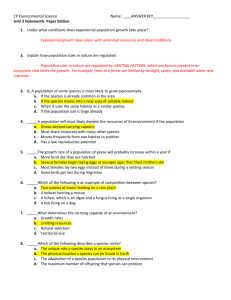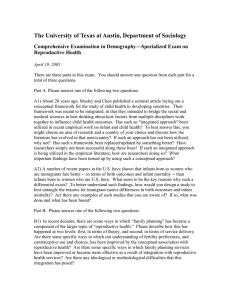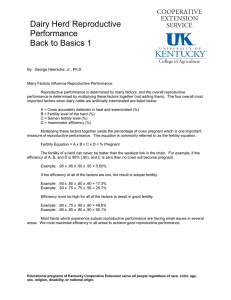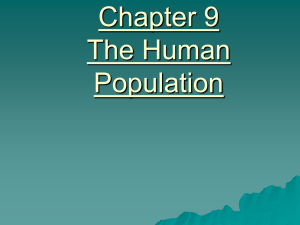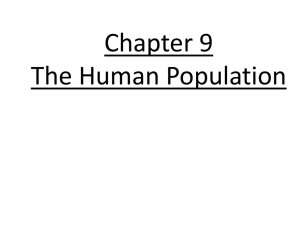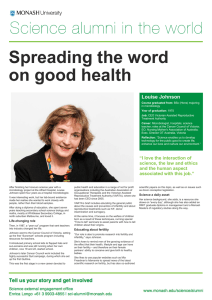Chapter 8 & 9 Review
advertisement
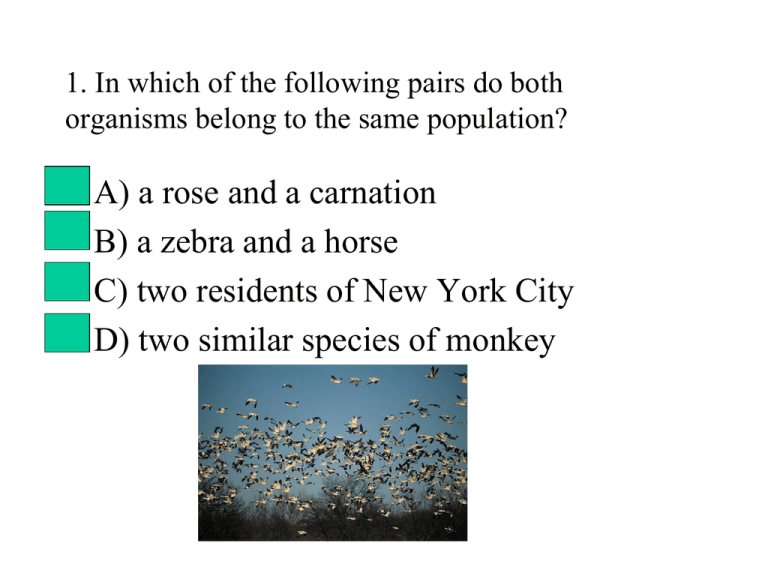
1. In which of the following pairs do both organisms belong to the same population? • • • • A) a rose and a carnation B) a zebra and a horse C) two residents of New York City D) two similar species of monkey Correct !! Next Question 2. Which of the following populations has a random dispersion? • • • • A) herd of sheep B) clover in a field C) school of fish D) mountain lion Correct !! Next Question 3.The growth rate of a population of geese will probably increase within a year if __________. • A) more birds die than are hatched • B) several females begin laying eggs at a younger age • C) most females lay two eggs instead of three during a nesting season • D) some birds get lost during migration. Correct !! Next Question 4. Which factor contributed the most to the exponential growth of the human population? • • • • A) higher fertility rates B) more food, better hygiene C) increased immigration D) higher birth rates Correct !! Next Question 5. A population will most likely deplete the resources of its environment if the population • A) must share resources with many other species. • B) moves frequently from one habitat to another. • C) grows beyond carrying capacity. • D) has a low reproductive potential. Correct !! Next Question 6. Which of the following would cause a population to decrease in a region. • • • • A) increased survivorship B) increased fertility rates C) decreased emigration D) decreased immigration Correct !! Next Question 7. Which of the following is an example of coevolution? • A) wolves that compete with each other for territory • B) bacteria that suddenly mutate in a lab • C) flowers that can be pollinated by only one species of insect • D) rabbits that invade a new habitat Correct !! Next Question 8. Which of the following has the highest reproductive potential? • • • • A) spiders B) bacteria C) polar bears D) cats Correct !! Next Question 9. An example of a population is • A) all the animals in the pond • B) all the plants and animals in the pond • C) all the bass in the ponds of Maryland and Pennsylvania • D) all the bass in a pond Correct !! Next Question 10. Which countries have Type I survivorship? • A) the most developed countries • B) the least developed countries • C) countries in the second stage of demographic transition • D) countries in the first stage of demographic transition Correct !! Next Question 11. In this century, the world population is likely to • A) remain the same. • B) continue to grow exponentially. • C) stabilize after fertility rates fall below replacement level. • D) decline rapidly because fertility rates are below replacement level. Correct !! Next Question 12. Educating women worldwide has lowered birthrates partly because • A) educated women are stay-at-home moms. • B) educated women use family planning techniques. • C) educated women bear many children to ensure some will survive. • D) all of the above Correct !! Next Question 13. An example of a cause of death that is density independent is • • • • A) disease. B) predation. C) earthquakes. D) limited resources. Correct !! Next Question 14. When a resource is consumed at the same rate at which the ecosystem produces the resource, it is called the • • • • A) final resource. B) carrying resource. C) capacity resource. D) limiting resource. Correct !! Next Question 15. A tree has moss growing on its bark. This relationship is known as • • • • A) predation. B) commensalism. C) mutualism. D) competition. Correct !! Next Question Congratulations, you are done! Click here to reset quiz Sorry, try again. Return to Question

